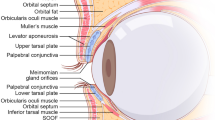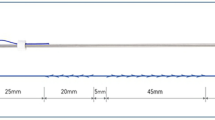Abstract
Objective
In the intermarginal split lamella with labial mucous membrane graft procedure to manage major trichiasis, the graft is usually sutured in the receptor bed using 6–0 polyglactin sutures. We aimed to compare the use of fibrin sealant to seal the graft to the receptor bed versus the conventional technique using sutures.
Methods
This is a retrospective comparative study of patients who underwent conventional intermarginal split lamella with labial mucous membrane graft or sutureless procedure using fibrin sealant (Tisseel, Baxter Healthcare Corp) between 2016 and 2021. Etiology of the trichiasis, procedure duration, postoperative discomfort and edema, complications, and follow-up period were extracted from these patients’ charts.
Results
Twenty-seven eyelids from 19 patients underwent the procedure: twelve patients underwent the sutureless procedure, while seven underwent the conventional procedure. Mean follow-up was 8.4 ± 2.9 months and 13.7 ± 6.5 months for the sutureless and conventional groups, respectively. Patients who underwent the sutureless procedure reported no postoperative foreign body sensation, while 71.4% of patients who underwent the conventional procedure reported some degree of ocular discomfort. In the sutureless group, operating time and postoperative edema were significantly reduced. Labial mucous membrane graft dehiscence was observed in one eyelid (8.3%) on the first postoperative day in the sutureless group. No dehiscence was observed in the conventional technique group.
Conclusion
The use of fibrin sealant showed to be a good alternative to conventional absorbable sutures. Advantages include expedited operating time, decreased postoperative discomfort, and expedite postoperative recovery.

Similar content being viewed by others
References
Ferreira IS, Bernardes TF, Bonfioli AA (2010) Trichiasis. Semin Ophthalmol 25:66–71
Scheie HG, Albert DM (1966) Distichiasis and trichiasis: origin and management. Am J Ophthlomol 61:718–720
Araújo FAM, Cruz AAV (2002) Eyelash abnormalities at the hospital of the school of medicine of Ribeirão Preto. Arq Bras Oftalmol 65:343–349
Ferraz CB, Meneghim RLRS, Galindo-Ferreiro A, Wanzeler ACV, Saruwatari MM, Satto LH, Padovani CR, Schellini AS (2018) Outcomes of two surgical techniques for major trichiasis treatment. Orbit 37(1):36–40
Millingen V (1888) De La Guérison radicale du trichiasis par la tarso-cheiloplastie. Arch Ophth 8:60–63
Ohkawara LE, Osaki MH, Osaki TH (2021) Use of fibrin sealant in the management of trichiasis. Ophthalmic Plast Reconstr Surg 37(3S):S120
Guhan S, Peng SL, Janbatian H, Saadeh S, Greenstein S, Bahrani A, Yeh TC, Melki SA (2018) Surgical adhesives in ophthalmology: history and current trends. Br J Ophthalmol 102:1328–1335
Rajak S, CollinBurton R (2012) Trachomatous trichiasis and its management in endemic countries. Surv Ophthalmol 57–341(2):105–135
Pham RT, Biesman BS, Silkiss RZ (2006) Treatment of trichiasis using an 810-nm diode laser: an efficacy study. Ophthalmic Plast Reconstr Surg 22(6):445–447
McCracken MS, Kikkawa DO, Vasani SN (2006) Treatment of trichiasis and distichiasis by eyelash trephination. Ophthalmic Plast Reconstr Surg 22(5):349–351
Toriumi DM, Chung VK, Cappelle QM (2016) Surgical adhesives in facial plastic surgery. Otolaryngol Clin N Am 49(3):585–599
Mobley SR, Hilinski J, Toriumi DM (2002) Surgical tissue adhesives. Facial Plast Surg Clin N Am 10(2):147–54
Horowitz B, Busch M (2008) Estimating the pathogen safety of manufactured human plasma products: application to fibrin sealants and to thrombin. Transfusion 48(8):1739–1753
Pilger D, von Sonnleithner C, Bertelmann E (2020) Assessing full thickness oral mucosal grafting: complications and postoperative outcomes in a broad collective of patients. BMJ Open Ophthalmol 5(1):e000337
Osaki TH, Sant’Anna AE, Osaki MH, Kikkawa DO, Yabumoto C, Yang P, Korn BS (2018) Management of severe cicatricial entropion with labial mucous membrane graft in cicatricial ocular surface disorders. J Craniofac Surg 29(6):1531–1534
Sant’Anna AEBPP, Sant’Anna ÉBPP, Osaki TH, Pereira Gomes JA (2021) A new option for treatment of severe cicatricial entropion in patients with Stevens-Johnson syndrome. Ocul Surf 22:80–82
Osaki TH, Sant’Anna AE, Osaki MH (2017) An alternative for permanent punctal occlusion: labial mucous membrane graft in the management of severe dry eye. Ophthalmic Plast Reconstr Surg 33(5):395–396
Funding
None.
Author information
Authors and Affiliations
Contributions
LEO: acquisition, analysis, and interpretation of data; drafting the work; final approval. MHO: design and conception of the study; analysis, and interpretation of data; critical revision for important intellectual content; final approval. SMA: acquisition, analysis, and interpretation of data; critical revision for important intellectual content; final approval. PYM: acquisition, analysis, and interpretation of data; critical revision for important intellectual content; final approval. THO: design and conception of the study; analysis, and interpretation of data; critical revision for important intellectual content; final approval.
Corresponding author
Ethics declarations
Conflict of interest
All authors have no conflict of interest.
Ethical approval
All procedures performed in studies involving human participants were in accordance with the ethical standards of the UNIFESP IRB (CAAE 52823521.7.0000.5505) and with the 1964 Helsinki declaration and its later amendments or comparable ethical standards.
Additional information
Publisher's Note
Springer Nature remains neutral with regard to jurisdictional claims in published maps and institutional affiliations.
Rights and permissions
Springer Nature or its licensor holds exclusive rights to this article under a publishing agreement with the author(s) or other rightsholder(s); author self-archiving of the accepted manuscript version of this article is solely governed by the terms of such publishing agreement and applicable law.
About this article
Cite this article
Ohkawara, L.E., Osaki, M.H., Alves, S.M. et al. A comparative study of conventional intermarginal split lamella with labial mucous membrane graft versus sutureless procedure using fibrin sealant to manage major trichiasis. Int Ophthalmol 43, 1459–1463 (2023). https://doi.org/10.1007/s10792-022-02541-w
Received:
Accepted:
Published:
Issue Date:
DOI: https://doi.org/10.1007/s10792-022-02541-w




